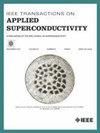Gamma-Ray Irradiation Characteristics of an Organic Olefin-Based Thermosetting Dicyclopentadiene Resin Under Vacuum Atmosphere
IF 1.8
3区 物理与天体物理
Q3 ENGINEERING, ELECTRICAL & ELECTRONIC
引用次数: 0
Abstract
An organic olefin-based thermosetting dicyclopentadiene (DCP) resin named TELENE was proposed as an impregnation material for Nb3Sn magnets to reduce the training. To verify the radiation resistance of the TELENE, gamma-ray irradiation experiments and three-point bending tests were conducted on the TELENE and the CTD-101K. The TELENE mixed with Gd2O2S powder was also applied for these measurements. The gamma-ray irradiation experiment was carried out up to nearly 20 MGy at room temperature using a Cobalt-60 source at the Takasaki Advanced Radiation Research Institute in Japan. For gamma irradiation in the absence of air, all resin samples were sealed in glass tubes and evacuated. The flexural strength and flexural modulus of each resin were measured by the three-point bending test before and after gamma-ray irradiation. The pure and mixed TELENE exhibits plastic deformation before the irradiation and can withstand larger strain than the CTD-101K. After irradiation, no decrease in flexural strength was observed up to 6 MGy for the pure TELENE and up to 17 MGy for the mixed TELENE. However, their strains at fracture decreased by more than 50% after 5 MGy irradiation.有机烯烃基热固性二环戊二烯树脂在真空气氛下的γ射线辐照特性
提出了一种基于有机烯烃的热固性二环戊二烯(DCP)树脂TELENE作为Nb3Sn磁体的浸渍材料,以减少训练。为了验证TELENE的抗辐射性能,对TELENE和CTD-101K进行了伽玛射线辐照实验和三点弯曲试验。TELENE与Gd2O2S粉末的混合也被用于这些测量。伽马射线辐照实验是在日本高崎高级辐射研究所使用钴-60源在室温下进行的,辐照强度接近20毫戈瑞。在没有空气的情况下,所有的树脂样品都密封在玻璃管中并抽真空。通过射线辐照前后的三点弯曲试验测量了每种树脂的抗弯强度和抗弯模量。纯TELENE和混合TELENE在辐照前均表现出塑性变形,并能承受比CTD-101K更大的应变。辐照后,纯TELENE的抗折强度在6 MGy和混合TELENE的17 MGy下均未见下降。但经5mgy辐照后,其断裂应变降低50%以上。
本文章由计算机程序翻译,如有差异,请以英文原文为准。
求助全文
约1分钟内获得全文
求助全文
来源期刊

IEEE Transactions on Applied Superconductivity
工程技术-工程:电子与电气
CiteScore
3.50
自引率
33.30%
发文量
650
审稿时长
2.3 months
期刊介绍:
IEEE Transactions on Applied Superconductivity (TAS) contains articles on the applications of superconductivity and other relevant technology. Electronic applications include analog and digital circuits employing thin films and active devices such as Josephson junctions. Large scale applications include magnets for power applications such as motors and generators, for magnetic resonance, for accelerators, and cable applications such as power transmission.
 求助内容:
求助内容: 应助结果提醒方式:
应助结果提醒方式:


